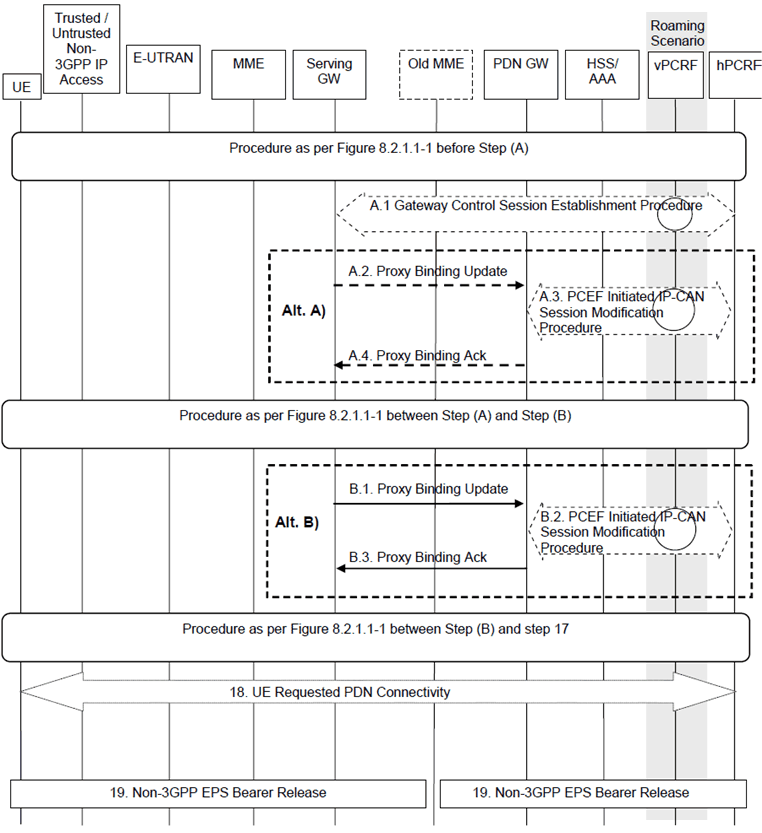Content for TS 23.402 Word version: 18.3.0
0…
4…
4.2…
4.2.2
4.2.3
4.3…
4.4…
4.5…
4.5.7…
4.6…
4.7…
4.7.2…
4.8…
4.8.2a…
4.9…
5…
5.2…
5.4…
5.5
5.6…
5.7…
5.8…
6…
6.2…
6.3
6.4…
6.4.3…
6.5…
6.6…
6.7…
6.8…
6.10…
6.13…
6.15…
7…
7.2…
7.3
7.4…
7.5…
7.6…
7.8…
7.10…
8…
8.2.1.2
8.2.1.3…
8.2.2
8.2.3…
8.2.6…
8.3…
8.4…
8.5…
9…
9.3…
9.4…
10…
13…
16…
16.1.2…
16.1.6…
16.2…
16.2.1a…
16.3…
16.4…
16.7…
16.8…
16.10…
17…
A…
C…
E…
8.2.1.2 Using PMIP-based S5/S8 p. 190
When a Trusted or Untrusted Non-3GPP IP Access to 3GPP Access handover occurs, the following steps are performed instead of and in addition to the steps performed in the GTP-based S5/S8 case (see previous clause). In the case of PMIP-based S5/S8, a Create Session Request and Modify Bearer Request is not sent from the Serving-GW to the PDN-GW. Rather, the serving GW interacts with the hPCRF and PMIP messages are exchanged between the Serving-GW and the PDN-GW.

Figure 8.2.1.2-1: Trusted/Untrusted Non-3GPP IP Access to E-UTRAN Handover over PMIP-based S2a and using PMIP-based S5/S8
(⇒ copy of original 3GPP image)
(⇒ copy of original 3GPP image)
In case of connectivity to multiple PDNs the following applies:
In case of connectivity to multiple PDNs the following applies:
- If the UE is connected to both 3GPP access and non-3GPP access before the handover of PDN connections to 3GPP access is triggered, steps 2 to 16 of Figure 8.2.1.1-1 shall be skipped and the UE shall only perform step 18 of Figure 8.2.1.2-1 for each PDN connection that is being transferred from non-3GPP access.
- If the UE is connected only to non-3GPP access before the handover of PDN connections to 3GPP access is triggered, steps 2 to 16 of Figure 8.2.1.1-1 shall be performed. In step 3 of Figure 8.2.1.1-1 the UE shall provide the APN corresponding to one of the PDN connections that are being transferred from non-3GPP access. The UE shall then repeat step 18 of Figure 8.2.1.2-1 for each of the remaining PDN connections that are being transferred from non-3GPP access.
- Step 19 of Figure 8.2.1.2-1 shall be repeated for each PDN connection that is being transferred from non-3GPP access.
Step A.1.
Steps between A and B.1 are described in clause 8.2.1.1.
The Serving-GW initiates a Gateway Control Session Establishment Procedure with the PCRF as specified in TS 23.203 to obtain the rules required for the Serving-GW to perform the bearer binding for all the active sessions the UE may establish as a result of the handover procedure.
If the updated QoS rules require establishment of dedicated bearer for the UE, the establishment of those bearers take place before step B1. The establishment of dedicated bearers in combination with the default takes place as described in Annex F of TS 23.401.
Step A.2.
The Serving-GW sends a PMIPv6 Proxy Binding Update (MN NAI, Lifetime, Access Technology Type, Handover Indicator, IP Address Requested, APN, GRE Key for downlink traffic, Additional Parameters) message to the PDN-GW. The MN NAI identifies the UE. The Lifetime field must be set to a non-zero value in the case of a registration. Access Technology Type is set to indicate 3GPP access to EPS. The Serving-GW includes request for IPv4 Home Address and/or IPv6 Home Network Prefix as specified in step C.2 of clause 5.2. The APN may be necessary to differentiate the intended PDN from the other PDNs supported by the same PDN-GW. The Serving-GW includes the EPS bearer identity of the default bearer received from the MME if multiple PDN connections to the same APN are supported. The optional Additional Parameters may contain information, for example, protocol configuration options.
Step A.3.
The PDN-GW executes a PCEF-Initiated IP-CAN Session Modification Procedure with the PCRF as specified in TS 23.203 to obtain the rules required for the PDN-GW to function as the PCEF for all the active IP sessions the UE has established with new IP-CAN type.
Step A.4.
The PDN-GW responds with a Proxy Binding Ack (MN NAI, Lifetime, UE Address Info, GRE key for uplink traffic, Charging ID, Additional Parameters) message to the Serving-GW. The MN NAI is identical to the MN NAI sent in the Proxy Binding Update. The Lifetime indicates the duration the binding will remain valid. The UE address info returns the IP Address assigned to the UE. IP address allocation by the PDN-GW is as specified in clause 4.7.1. If the PDN-GW sends the DHCPv4 Address Allocation Procedure Indication in the Proxy Binding Acknowledgement message, the UE IPv4 address assigned by the PDN-GW is not provided as part of the default bearer activation procedures to the UE. In this case, the Serving-GW does not forward the IPv4 address assigned by the PDN-GW to the MME, but sets the PDN Address to 0.0.0.0 in the message to the MME. If the corresponding Proxy Binding Update contains the EPS bearer identity, the PDN-GW shall acknowledge if multiple PDN connections to the given APN are supported. The optional Additional Parameter information element may contain other information, including for example Protocol Configuration Options. The Serving-GW acts as the MAG (in terms of PMIPv6). Since this step is triggered by the Proxy Binding Update message from the Serving-GW in step A.2, it can occur after step A.2 and does not need to wait for step A.3.
The Charging Id provided by the PGW is the Charging Id previously assigned to the PDN connection for the non-3GPP access.
Step B.1-B.3.
Steps between B.1 and 18 are described in clause 8.2.1.1.
Corresponds to steps A.2 - A.4, respectively.
Step 18.
For connectivity to multiple PDNs, the UE establishes connectivity to each PDN that is being transferred from non-3GPP access, besides the PDN connection established in the steps above, by executing the UE requested PDN connectivity procedure specified in clause 5.6.1.
Step 19.
The PDN-GW shall initiate resource allocation deactivation procedure in the trusted/untrusted non-3GPP IP access as defined in clause 6.12 or clause 7.9.